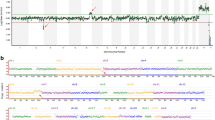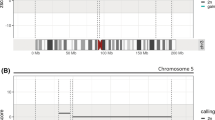Abstract
Microsatellite instability (MSI) has been described in cancer cells and in vitro cell lines, and meiotic changes in repeat length have also been documented. We report the novel observation of somatic microsatellite mutation (SMM) in normal human somatic cells in vivo, detected while genotyping 5,767 prenatal samples (4,640 amniotic fluid samples and 1,127 chorionic villus biopsies) as a diagnostic test for exclusion of trisomy 13, 18 or 21. Quantitative fluorescence-PCR using a multiplex of 12 primer pairs, for four loci on each of the three chromosomes, was followed by fragment analysis on a capillary-based genetic analyser. Forty-seven (4.2%) chorionic villus samples and six (0.1%) amniotic fluid samples showed allelic mosaicism, interpreted as SMM. In four cases, analysis of parental blood samples confirmed the presence of a de novo allele. SMM was detected at all but two of the 12 loci tested, and the incidence of mutation increased with repeat length. Detection of SMM in chorionic villus samples may imply less rigorous correction of replication errors in these extra-embryonic tissues, and is likely to have been facilitated by clonal expansion in the small samples of tissue tested. The presence of the same phenomenon in six amniotic fluid samples would imply that in these pregnancies, the instability event had occurred early in embryogenesis. The results suggest that defective proof reading during DNA replication may be more common in non-malignant human somatic tissue than previously recognised.





Similar content being viewed by others
References
Banchs I, Bosch A, Guimera J, Lazaro C, Puig A, Estivill X (1994) New alleles at microsatellite loci in CEPH families mainly arise from somatic mutations in the lymphoblastoid cell lines. Hum Mutat 3:365–372
Bhattacharyya NP, Skandalis A, Ganesh A, Groden J, Meuth M (1994) Mutator phenotypes in human colorectal carcinoma cell lines. Proc Natl Acad Sci U S A 91:6319–6323
Cirigliano V, Ejarque M, Canadas MP, Lloveras E, Plaja A, Perez MM, Fuster C, Egozcue J (2001) Clinical application of multiplex quantitative fluorescent polymerase chain reaction (QF-PCR) for the rapid prenatal detection of common chromosome aneuploidies. Mol Hum Reprod 7:1001–1006
Ellegren H (2000) Heterogeneous mutation processes in human microsatellite DNA sequences. Nat Genet 24:400–402
Ionov Y, Peinado MA, Malkhosyan S, Shibata D, Perucho M (1993) Ubiquitous somatic mutations in simple repeated sequences reveal a new mechanism for colonic carcinogenesis. Nature 363:558–561
Kunkel TA, Bebenek K (2000) DNA replication fidelity. Annu Rev Biochem 69:497–529
Leopoldino A, Pena S (2002) The mutational spectrum of human autosomal tetranucleotide microsatellites. Hum Mutat 21:71–79
Levinson G, Gutman GA (1987) Slipped-strand mispairing: a major mechanism for DNA sequence evolution. Mol Biol Evol 4:203–221
Mann K, Fox SP, Abbs SJ, Yau SC, Scriven PN, Docherty Z, Ogilvie CM (2001) Development and implementation of a new rapid aneuploidy diagnostic service within the UK National Health Service and implications for the future of prenatal diagnosis. Lancet 358:1057–1061
Parsons R, Li GM, Longley M, Modrich P, Liu B, Berk T, Hamilton SR, Kinzler KW, Vogelstein B (1995) Mismatch repair deficiency in phenotypically normal human cells. Science 268:738–740
Pertl B, Kopp S, Kroisel PM, Tului L, Brambati B, Adinolfi M (1999) Rapid detection of chromosome aneuploidies by quantitative fluorescence PCR: first application on 247 chorionic villus samples. J Med Genet 36:300–303
Schmidt W, Jenderny J, Hecher K, Hackeloer BJ, Kerber S, Kochhan L, Held KR (2000) Detection of aneuploidy in chromosomes X, Y, 13, 18 and 21 by QF-PCR in 662 selected pregnancies at risk. Mol Hum Reprod 6:855–860
Shibata D, Peinado MA, Ionov Y, Malkhosyan S, Perucho M (1994) Genomic instability in repeated sequences is an early somatic event in colorectal tumorigenesis that persists after transformation. Nat Genet 6:273–281
Vilkki S, Tsao JL, Loukola A, Poyhonen M, Vierimaa O, Herva R, Aaltonen LA, Shibata D (2001) Extensive somatic microsatellite mutations in normal human tissue. Cancer Res 61:4541–4544
Weber JL, Wong C (1993) Mutation of human short tandem repeats. Hum Mol Genet 2:1123–1128
Acknowledgements
We thank S.P. Fox and all members of the prenatal team for their help and contribution to this work. The ABI 3100 genetic analyser was funded by the Charitable Foundation of Guy's and St Thomas' Hospital.
Author information
Authors and Affiliations
Corresponding author
Rights and permissions
About this article
Cite this article
Mann, K., Donaghue, C. & Ogilvie, C.M. In vivo somatic microsatellite mutations identified in non-malignant human tissue. Hum Genet 114, 110–114 (2003). https://doi.org/10.1007/s00439-003-1032-3
Received:
Accepted:
Published:
Issue Date:
DOI: https://doi.org/10.1007/s00439-003-1032-3




